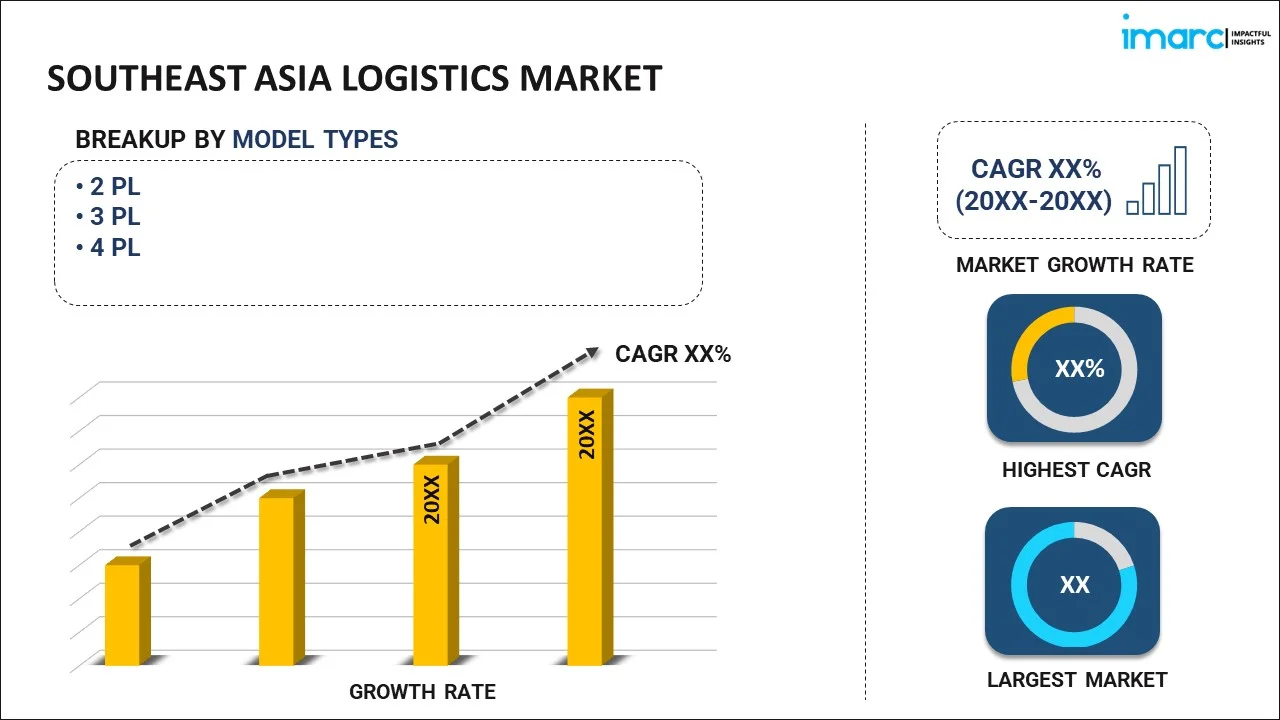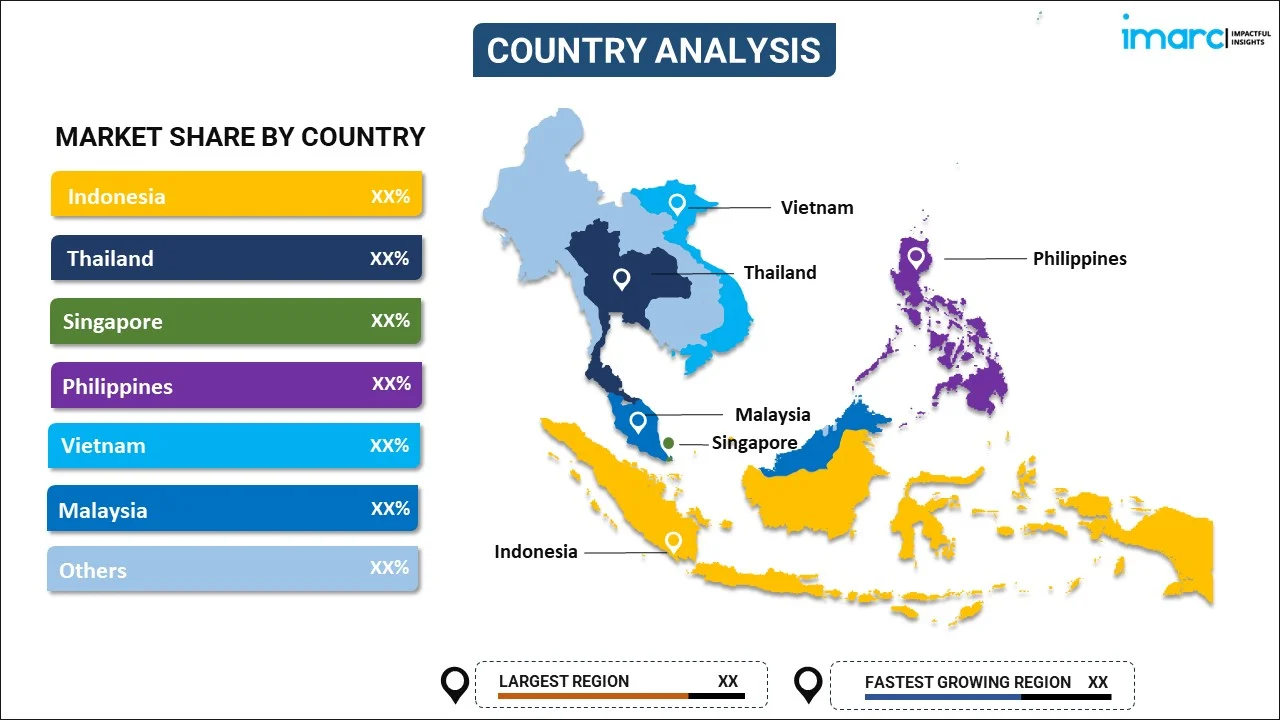
Southeast Asia Logistics Market Report by Model Type (2 PL, 3 PL, 4 PL), Transportation Mode (Roadways, Seaways, Railways, Airways), End Use (Manufacturing, Consumer Goods, Retail, Food and Beverages, IT Hardware, Healthcare, Chemicals, Construction, Automotive, Telecom, Oil and Gas, and Others), and Country 2024-2032
Market Overview:
The Southeast Asia logistics market size is projected to exhibit a growth rate (CAGR) of 5.96% during 2024-2032. The expansion of the e-commerce sector, rapid development in the infrastructure industry, the implementation of various government policies and initiatives, rising urbanization and growing middle-class population, and the increasing utilization of smart logistics solutions represent some of the key factors driving the market.
|
Report Attribute
|
Key Statistics
|
|---|---|
|
Base Year
|
2023 |
|
Forecast Years
|
2024-2032
|
|
Historical Years
|
2018-2023
|
| Market Growth Rate (2024-2032) | 5.96% |
Logistics refers to the detailed organization and implementation of a complex operation for transporting goods to their final destination efficiently and cost-effectively. It is an essential component of supply chain management, comprising of planning, coordination, storage, and movement of resources, such as materials, inventory, and equipment. Logistics involves the packaging of supplies, containers, pallets, and vehicles, supported by technology systems for inventory management and routing. It is utilized in various sectors, including manufacturing, retail, food services, healthcare, construction, automotive, technology, defense, and agriculture. Logistics aid in reducing overhead costs, improving customer satisfaction, and enhancing inventory management. Moreover, it is extensively used for streamlining operations, minimizing waste, fostering sustainability, facilitating global trade, promoting innovation, enhancing scalability, and increasing reliability.
Southeast Asia Logistics Market Trends:
The expansion of the e-commerce sector, prompting the demand for robust delivery networks and warehousing solutions, is one of the major factors boosting the market growth. Moreover, the escalating infrastructure development, including ports, roads, and airports, improving interconnectivity within the region is favoring the market growth. Along with this, the implementation of various government policies and initiatives, facilitating investments and trade in the region, are fostering the market growth. Besides this, the rising urbanization, coupled with the growing middle-class population, demanding faster and more reliable delivery services is supporting the market growth. Apart from this, the widespread adoption of automation, advanced tracking systems (ATS), and data analytics to enhance operational efficiency and transparency is positively impacting the market growth. In line with this, the increasing utilization of smart logistics solutions, leveraging the Internet of Things (IoT), artificial intelligence (AI), and machine learning (ML) to optimize supply chains and reduce costs, is catalyzing the market growth. Additionally, the ongoing shift towards sustainability, prompting the adoption of green practices and eco-friendly vehicles, is boosting the market growth. Furthermore, the introduction of regional trade agreements that simplify cross-border transactions and eliminate trade barriers is propelling the market growth. In addition to this, the rising diversification of manufacturing bases, as firms aim to mitigate risk and reduce reliance on single markets, is bolstering the market growth. Additionally, the growing trade of perishable goods in the food and pharmaceuticals sector, requiring specialized logistics services that can manage temperature-controlled supply chains, is providing an impetus to the market growth. Apart from this, the growing consumer demand for faster and more flexible delivery options, leading to innovative last-mile delivery solutions, is acting as a growth-inducing factor. In line with this, the increasing experimentation with local delivery hubs, drones, and autonomous vehicles by startups and established logistics players is anticipated to drive the market growth.
Southeast Asia Logistics Market Segmentation:
IMARC Group provides an analysis of the key trends in each segment of the market, along with forecasts at the regional and country levels for 2024-2032. Our report has categorized the market based on model type, transportation mode, and end use.
Model Type Insights:

- 2 PL
- 3 PL
- 4 PL
The report has provided a detailed breakup and analysis of the market based on the model type. This includes 2 PL, 3 PL, and 4 PL.
Transportation Mode Insights:
- Roadways
- Seaways
- Railways
- Airways
A detailed breakup and analysis of the market based on the transportation mode have also been provided in the report. This includes roadways, seaways, railways, and airways.
End Use Insights:
- Manufacturing
- Consumer Goods
- Retail
- Food and Beverages
- IT Hardware
- Healthcare
- Chemicals
- Construction
- Automotive
- Telecom
- Oil and Gas
- Others
The report has provided a detailed breakup and analysis of the market based on the end use. This includes manufacturing, consumer goods, retail, food and beverages, IT hardware, healthcare, chemicals, construction, automotive, telecom, oil and gas, and others.
Country Insights:

- Indonesia
- Thailand
- Singapore
- Philippines
- Vietnam
- Malaysia
- Others
The report has also provided a comprehensive analysis of all the major regional markets, which include Indonesia, Thailand, Singapore, Philippines, Vietnam, Malaysia, and Others.
Competitive Landscape:
The market research report has also provided a comprehensive analysis of the competitive landscape in the market. Competitive analysis such as market structure, key player positioning, top winning strategies, competitive dashboard, and company evaluation quadrant has been covered in the report. Also, detailed profiles of all major companies have been provided.
Southeast Asia Logistics Market Report Coverage:
| Report Features | Details |
|---|---|
| Base Year of the Analysis | 2023 |
| Historical Period | 2018-2023 |
| Forecast Period | 2024-2032 |
| Units | US$ Million |
| Scope of the Report | Exploration of Historical and Forecast Trends, Industry Catalysts and Challenges, Segment-Wise Historical and Predictive Market Assessment:
|
| Model Types Covered | 2 PL, 3 PL, 4 PL |
| Transportation Modes Covered | Roadways, Seaways, Railways, Airways |
| End Uses Covered | Manufacturing, Consumer Goods, Retail, Food and Beverages, IT Hardware, Healthcare, Chemicals, Construction, Automotive, Telecom, Oil and Gas, Others |
| Countries Covered | Indonesia, Thailand, Singapore, Philippines, Vietnam, Malaysia, Others |
| Customization Scope | 10% Free Customization |
| Report Price and Purchase Option | Single User License: US$ 3699 Five User License: US$ 4699 Corporate License: US$ 5699 |
| Post-Sale Analyst Support | 10-12 Weeks |
| Delivery Format | PDF and Excel through Email (We can also provide the editable version of the report in PPT/Word format on special request) |
Key Questions Answered in This Report:
- How has the Southeast Asia logistics market performed so far and how will it perform in the coming years?
- What has been the impact of COVID-19 on the Southeast Asia logistics market?
- What is the breakup of the Southeast Asia logistics market on the basis of model type?
- What is the breakup of the Southeast Asia logistics market on the basis of transportation mode?
- What is the breakup of the Southeast Asia logistics market on the basis of end use?
- What are the various stages in the value chain of the Southeast Asia logistics market?
- What are the key driving factors and challenges in the Southeast Asia logistics?
- What is the structure of the Southeast Asia logistics market and who are the key players?
- What is the degree of competition in the Southeast Asia logistics market?
Key Benefits for Stakeholders:
- IMARC’s industry report offers a comprehensive quantitative analysis of various market segments, historical and current market trends, market forecasts, and dynamics of the Southeast Asia logistics market from 2018-2032.
- The research report provides the latest information on the market drivers, challenges, and opportunities in the Southeast Asia logistics market.
- Porter's five forces analysis assist stakeholders in assessing the impact of new entrants, competitive rivalry, supplier power, buyer power, and the threat of substitution. It helps stakeholders to analyze the level of competition within the Southeast Asia logistics industry and its attractiveness.
- Competitive landscape allows stakeholders to understand their competitive environment and provides an insight into the current positions of key players in the market.
Need more help?
- Speak to our experienced analysts for insights on the current market scenarios.
- Include additional segments and countries to customize the report as per your requirement.
- Gain an unparalleled competitive advantage in your domain by understanding how to utilize the report and positively impacting your operations and revenue.
- For further assistance, please connect with our analysts.
 Inquire Before Buying
Inquire Before Buying
 Speak to an Analyst
Speak to an Analyst
 Request Brochure
Request Brochure
 Request Customization
Request Customization




.webp)




.webp)












